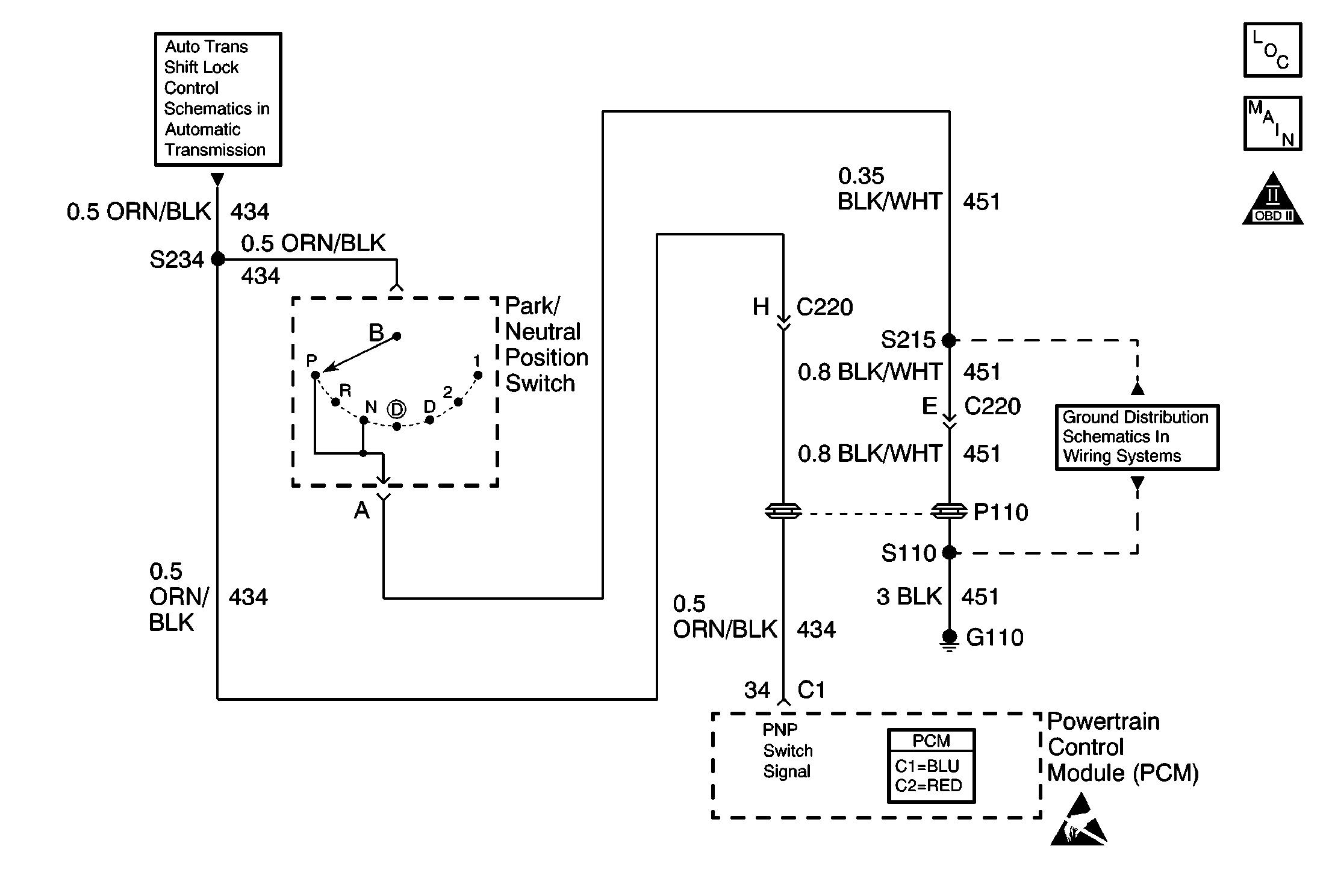
Circuit Description
The Park/Neutral Position (PNP) switch contacts are closed to ground in park and neutral. The PCM applies a voltage (about 12.0 Volts) to the switch. When the gear selector is in the park or neutral position, the PNP switch is closed and the PCM senses low signal voltage. When the gear selector is in reverse or a drive range, the PNP switch opens, and the PCM senses high signal voltage. The PCM will increase the idle air rate to compensate for the additional load on the engine when the transmission is in gear.
Some of the PCMs other uses for the PNP signal are:
| • | Vehicle Speed Sensor (VSS) diagnostics |
| • | Exhaust Gas Recirculation (EGR) operation |
Diagnostic Aids
Important:
• Remove any debris from the PCM connector surfaces before servicing
the PCM. Inspect the PCM connector gaskets when diagnosing/replacing the PCM.
Ensure that the gaskets are installed correctly. The gaskets prevent water
intrusion into the PCM. • For any test that requires probing the PCM or component harness
connectors, use the J 35616
connector test adapter kit. Using this kit prevents any damage to
the harness connector terminals. Refer to
Using Connector Test Adapters
in Wiring Systems.
A PNP switch that does not close or an open circuit may cause the engine idle speed to drop when the vehicle is shifted into gear.
A switch that will not open or the signal circuit shorted to ground will cause the EGR system to be inoperative, possibly resulting in excessive spark knock.
Inspect all related wiring and connectors including the connections at the PCM. These may cause an intermittent malfunction. Inspect for damaged, corroded or pushed out terminals.
Step | Action | Value(s) | Yes | No |
|---|---|---|---|---|
1 | Did you perform the Powertrain On-Board Diagnostic (OBD) System Check? | -- | ||
2 |
Does the scan tool indicate Park/Neutral for both positions? | -- | ||
3 | Shift the transmission into Drive. Does the scan tool indicate Drive? | -- | Go to Diagnostic Aids | |
4 |
Does the scan tool indicate Park/Neutral? | -- | ||
5 | Probe terminal B in the PNP switch harness connector using a fused jumper wire connected to ground. Refer to Using Fused Jumper Wires in Wiring Systems. Does the scan tool indicate Park/Neutral? | -- | ||
6 |
Does the test lamp illuminate? | -- | ||
7 | Disconnect the Park/Neutral Position switch connector. Does the scan tool indicate Drive (R-D321)? | -- | ||
8 |
Does the scan tool indicate Drive (R-D321)? | -- | ||
9 |
Did you find and correct the condition? | -- | ||
10 |
Did you find and correct the condition? | -- | ||
11 | Repair the open PNP signal circuit. Refer to Wiring Repairs in Wiring Systems. Is the repair complete? | -- | -- | |
12 | Repair the PNP signal circuit shorted to ground. Refer to Wiring Repairs in Wiring Systems. Is the repair complete? | -- | -- | |
13 | Repair the open PNP ground circuit. Refer to Wiring Repairs in Wiring Systems. Is the repair complete? | -- | -- | |
14 | Replace the PNP switch. Refer to Park/Neutral Position Switch Replacement in Automatic Transmission. Is the repair complete? | -- | -- | |
15 |
Important:: Program the replacement PCM. Refer to Powertrain Control Module Replacement/Programming . Replace the PCM. Is the action complete? | -- | -- | |
16 | Operate the vehicle within the conditions under which the original symptom was noted. Does the system now operate properly? | -- | System OK |
